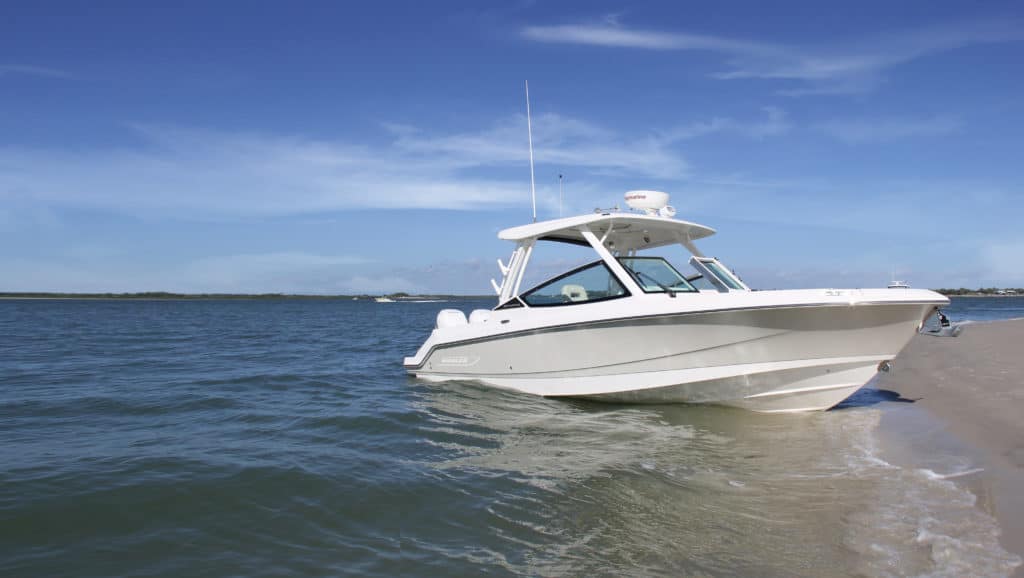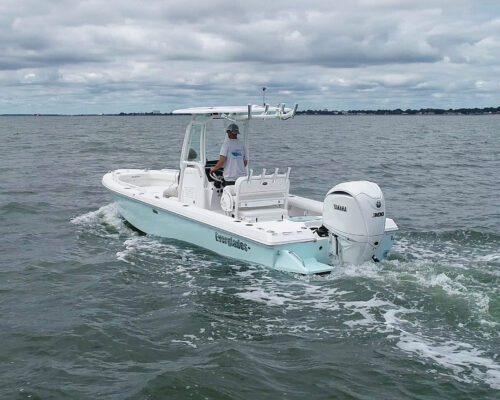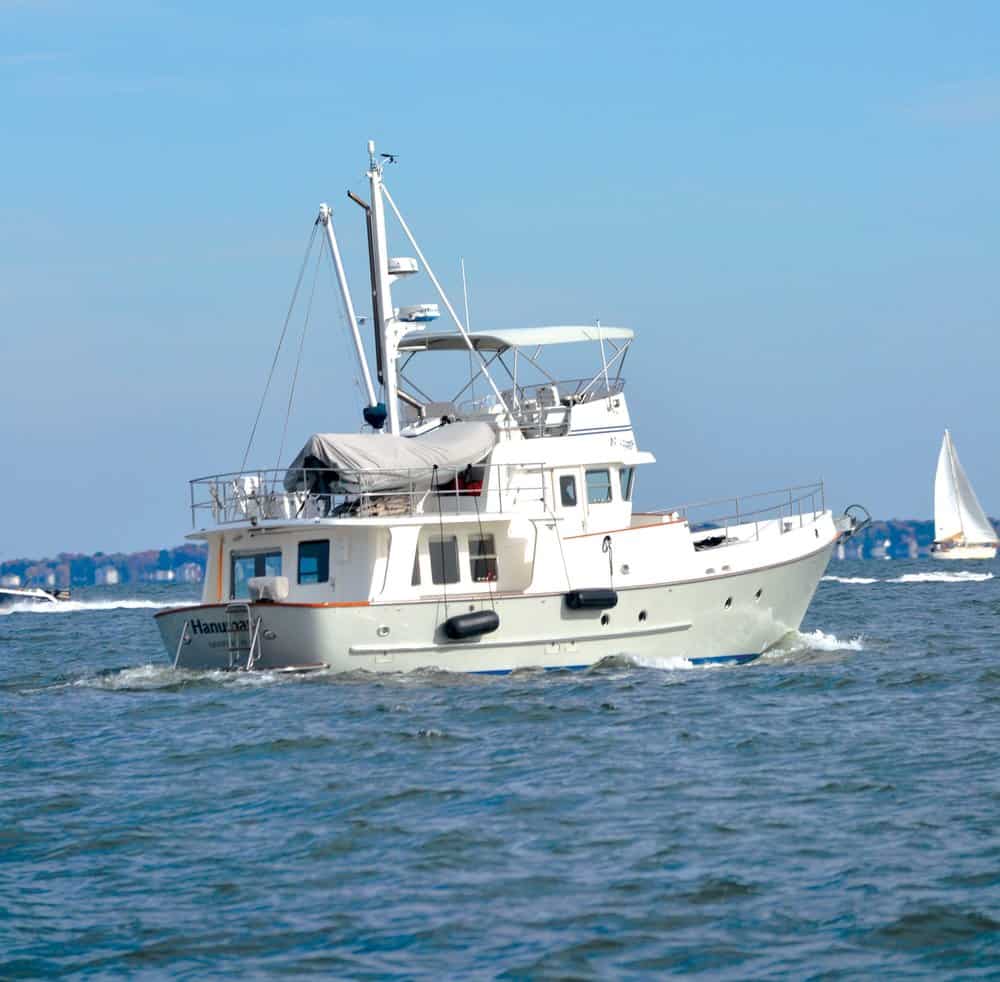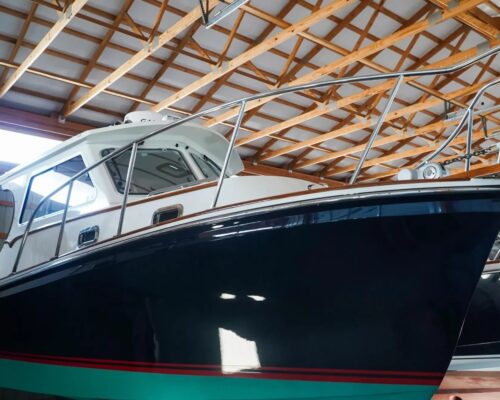This new day-cruiser provides comfort and action for everybody.
Boston Whaler’s new Vantage 280 is a true 21st-century family boat. Thanks to Chesapeake Whalertowne, Chesapeake Bay Magazine was able to catch a ride on hull #2 on a windy day above the Bay Bridge, with the new boat’s enthusiastic owner aboard. He and his active family (water-loving wife and sons aged 8 and 10) had put enough hours on her to give us a broad sense of her capabilities, and a brisk southerly wind pushing against an ebb current gave us enough sea to let her show off her performance.
The 280 is a completely new model, not a refresh of the existing and perfectly competent Vantage 270. The 280 runs on a 21-degree planing surface, with a sharp bow and broad chines to cleave seas open and throw them well to the side, as we saw while running in two- to three-footers. A pair of Mercury’s new silky-smooth, 300-hp V-8 Verados allowed the boat to loaf along comfortably at 27 knots (3,500 rpm) in that sharp chop. Top speed is right on 50 knots, which is more than is usually practical. More to the point is comfortable cruising at 25-35 knots, depending on conditions, with a range of 275-235 nautical miles and plenty of power and space to carry up to a dozen people. Mercury’s Joystick Piloting made close-quarter handling a piece of cake, as did the electronic steering, Skyhook electronic position keeping, and an integrated autopilot.
Another new feature of the 280 is a frame and windshield for the hardtop, incorporated into the hull and deck around the helm and cockpit. It’s a result of the Whaler design team’s integrated approach to structural engineering, combined with excellent sightlines, minimal wind noise, and weather protection. Our test boat’s hardtop carried an optional sunshade for the aft cockpit that’s ideal in summer, and the owners have fitted it with a full set of weather curtains that will make fall boating on the Bay comfortable, right up to the Christmas lights parades.
The Vantage 280’s mission is day cruises. The Whaler design team, all boaters themselves, listened carefully to customers and dealers, including the folks at Whalertowne, and then thought long and hard about how to incorporate what they heard. Safety came first, with Whaler’s trademark foam-filled, unsinkable hull, followed by the able hull design and performance we saw in our sea trial.
The interior details show the depth of the design team’s thinking. Look at how this test boat fits the needs of its family. First mission, with two active boys, is swimming and tubing. The owner reported that while his sons and their friends love the way outboards make the boat perform, they don’t like being on the transom or in the water around the propellers, even if the engines are tilted all the way up. On the other hand, they love getting into the water from the portside dive door, which has its own stowable ladder for climbing out after a dip. The freshwater shower wand in the port stern quarter is good to wash off salt (and the cockpit is self-bailing). There is plenty of space around the boat, especially in the helm (starboard) console for storage of ski vests and water toys, and the towline ties to a bit in the center aft edge of the hardtop. Meanwhile, the three-way port settee and the comfortable aft-facing seat to starboard offer comfortable perches for observers during tow sessions. The three-way can work as a back-to-back seat, a forward-facing lounge with angled back, or a flat lounge. Our test boat’s family members happily use it all three ways, depending on what they are up to.
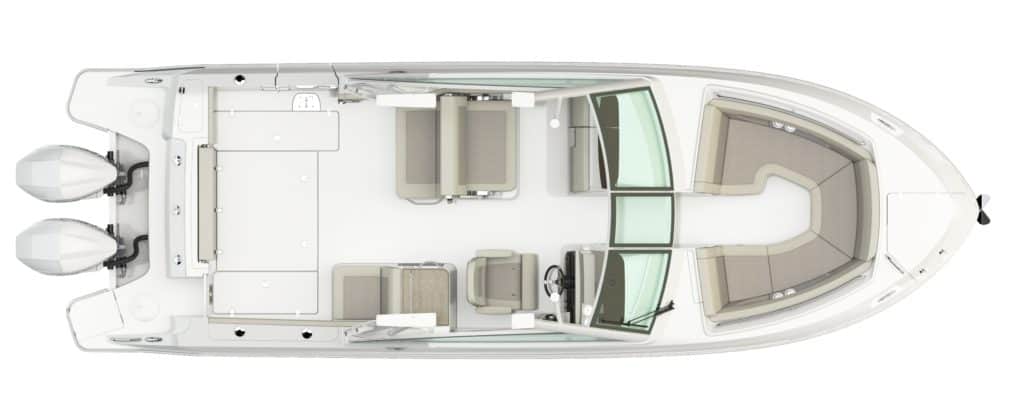
Active families need food and drink, and places to sit while eating. The aft-facing starboard seat holds an 11-gallon cooler beneath, and built into its forward side, just behind the helm, is a sink with counter and space below for storage. Our test boat had an optional “summer kitchen” there, with a 12-volt refrigerator, 2,000-watt inverter, Corian counter top, electric grill, and shore power connection with battery charger. For carry-on coolers, the owner reported that his two soft-side Yetis fit neatly under the transom seat even when it is folded down. The three-way lounge to port mounts a teak table on its after edge for serving. Whaler designers placed multiple cup holders in strategic places.
Food and drink on an all-day trip lead to the need for a head. It’s built into the port console, which is a few inches wider than the starboard one, though the difference is generally not noticeable. The result, though, is a roomy, well-lit, ventilated, comfortable space for a Vacu-Flush toilet with a holding tank and washbasin. Our boat’s owner expressed initial skepticism but reports that his family actually likes using it. Headroom is 54”, comfortable for anyone sitting, even one “linebacker” friend who found he could adjust to doing all business that way.
For the pure joy of a boat ride, whether headed to a waterside restaurant or a celebration, the main cockpit comfortably seats six to eight, depending on size. The V-shaped bow cockpit provides either a pair of forward-facing lounges or seating for six leaning back against the cushioned bolsters, under the watchful eye of the skipper. The bow deck holds a pair of essential tools. One is a windlass controlling an anchor mounted through the stem head. The owners appreciate the ease of deploying the system. Beside it, for visits to islands and sandbars, is a sturdy telescopic ladder. For those visits, a Fusion stereo and Sirius satellite radio are optional.
One footnote to boat rides on the Vantage 280: The owners found themselves one evening idling back into the narrow mouth of their home river at six knots because of boat traffic and decided they liked it so much they continued at that peaceful speed all the way home. Now they often enjoy slipping along, exploring creeks.
Fishing? “We’re going to learn,” said the owners, who are working their way through their boat’s Raymarine Axiom electronics, which include multiple sonar options, electronics charts, and radar. The dual-console with hardtop layout lends itself to trolling, with rod holders and attachment points for several ways of rigging lines and planer boards. The bow and stern cockpits certainly accommodate bottom fishing with bait for panfish. They would also serve for light tackle jigging and run-and-gun chasing breaking fish, or a couple of wire-line trollers carefully working bottom-bouncers around structures like the Bay Bridge or the Chesapeake Bay Bridge-Tunnel. Lockable rod storage is optional for the starboard console. The cockpit sole holds a pair of 25-gallon fishboxes, and the port stern quarter holds a lighted 19-gallon livewell. This Vantage’s able hull and weather curtains would suit it especially well to fishing through the late fall season.
Finally, here’s another use for a long-legged day boat that’s competent anywhere from Baltimore to the Virginia Capes: Why not cruise it, overnighting at shoreside facilities? Chesapeake Bay Media guides and county tourism offices provide plenty of resources for finding anything from luxury hotels with marinas to town wharves with nearby B&Bs. On the upper Bay, consider a Whalertowne/Annapolis-to-Chestertown-to-Havre de Grace-to-Baltimore-to-home circuit. How about a run from Chesapeake Boat Basin in Kilmarnock across the Middle Bay to Tangier, Smith Island, Crisfield, Onancock, and back home? Or from Lynnhaven Marine up the James River to Smithfield, then over into the Chickahominy to Holdcroft, back up the James to Richmond, and down to Kingsmill on the way home?
What Chesapeake adventures could you perpetrate with Boston Whaler’s new Vantage 280? The biggest limit may be your imagination.

